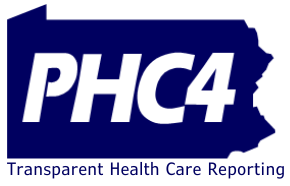It is well known that hospitals are key data sources for Pennsylvania Health Care Cost Containment Council (PHC4) reports. What may not be so widely appreciated is the fact that they also comprise one of the largest bodies of users of PHC4 data and rely heavily on it for decision-making. Understanding how two health care systems use PHC4 data illustrates the importance of this mutually beneficial relationship.
WellSpan Health
WellSpan Health is a not-for-profit health care system serving south central Pennsylvania as well as northern Maryland. It includes two hospitals (York and Gettysburg), with more than 600 beds; regional referral services including neonatology, trauma, cardiology, orthopedics, neurosciences and oncology; and a community teaching hospital with more than 500 residents and medical students and a research center. It is also the largest (and in some areas, the only) provider of behavioral health services in the region.
One of the ways WellSpan uses PHC4 inpatient discharge and ambulatory/outpatient data—which contain more than 70 data fields that include clinical, utilization and patient-demographic information—is to understand health care services consumption patterns across its geographic region.
Looking at trends in demand for various health care services by local communities informs WellSpan’s strategic planning. By analyzing “outmigration patterns” (i.e., residents who travel out of the area for certain services), WellSpan can plan for and deliver those services, many of which are medical specialties, within its system.
“We are always working to strengthen the continuum of care we provide patients,” said David Kimpel, WellSpan’s Planning Database Administrator. “PHC4 data is actionable. It helps us to identify any gaps in care, as we continue to improve clinical outcomes and patient experience.”
This data-driven approach reinforces WellSpan’s ongoing mission of providing patients with an integrated clinical and administrative process that facilitates treating complex medical conditions that require coordination across multiple specialties while also making health care delivery more cost-efficient.
In addition to its treatment centers for such specialized clinical areas as neurosurgery, cardiovascular services, pediatric behavioral health, and oncology, the integrated health system soon will be adding a surgery and rehabilitation hospital on its Apple Hill campus in York. The 73-bed facility will provide a specialized treatment environment for patients requiring orthopedic and spine surgery as well as for patients who may require inpatient rehabilitation.
“We are always striving to understand, plan for, and meet the growing medical needs of our local communities,” said Kimpel. “And PHC4 data helps us do that.”
Charles Cole Memorial Hospital
Charles Cole Memorial Hospital (CCMH) is another health care system that uses PHC4 data to meet the needs of its region. Located in Coudersport, it is the only hospital for 40 miles in any direction and serves communities throughout Potter, McKean, Cameron and Tioga Counties. The region is primarily rural, with a low-density population of approximately 45,000 and an above-average percentage of older and low-income residents. Most of the local roads are secondary in nature, and the area is mountainous, making travel difficult for much of the winter months.
Given both the geography and demographics of its region, Charles Cole has been designated a Critical Access Hospital by the Centers for Medicare and Medicaid Services (CMS). Additionally, the federal Health Resources and Services Administration has given the area the Health Professional Service Areas (HPSA) and Medically Underserved Areas (MUA) designations, indicating that the facility operates in a region with shortages of health service providers and that there are a significant number of people within its population who face economic hardships that adversely impact their access to health care.
Operating within this environment, Charles Cole uses Council data to understand and address the health care needs of its local communities. Using customized data sets provided by PHC4, CCMH can obtain a “health care profile” of the local population as well as track utilization patterns for health care services to understand the kinds of treatments residents may be forced to travel outside the region to receive. Additionally, the data helps the hospital predict whether there would be sufficient potential patient volume to justify the financial investment in certain services.
“PHC4 data has helped us to understand what could otherwise be difficult to quantify. It has helped us assess patient outmigration for hospital services so that we can identify ways to improve care and provide needed services when we can,” said Janice Walters, Executive Director, Revenue Systems and Primary Care Services, CCMH. “By meeting the demand for these services locally, we can reduce the clinical risks associated with traveling long distances, better coordinate care, and reduce costs for many patients.”
Despite its always limited financial resources, Charles Cole has developed a robust health system that includes acute inpatient and outpatient care, an inpatient geriatric behavioral health unit, a skilled nursing facility, rehabilitation services, comprehensive oncology services, home health and hospice care, along with specialist services such as orthopedics, podiatry, pain management, and urology. In addition, it operates primary care offices that cover family, internal, obstetric and pediatric medicine in ten outlying rural communities. The access it provides to those needing obstetric and newborn services in the region is particularly important.
PHC4 data is also used by CCMH to provide clinical “benchmarking” of the quality of its care. “With the relatively small number of cases we encounter in many areas, it is important to have a larger data set and risk adjustment measures to help us evaluate our clinical performance, in everything from infection control to readmissions,” noted Walters. “PHC4 data and analysis help us objectively assess and continually improve the quality of our care.”
The current fiscal challenge faced by many hospitals in this age of austerity is particularly acute for Charles Cole Memorial Hospital, upon whom so many in the region rely for medical services. “We use every resource at our disposal to bring high-quality care to our communities,” said Walters. “And PHC4 data plays an important role in that mission.”
Return to the Case Studies page: VIEW ALL CASE STUDIES




